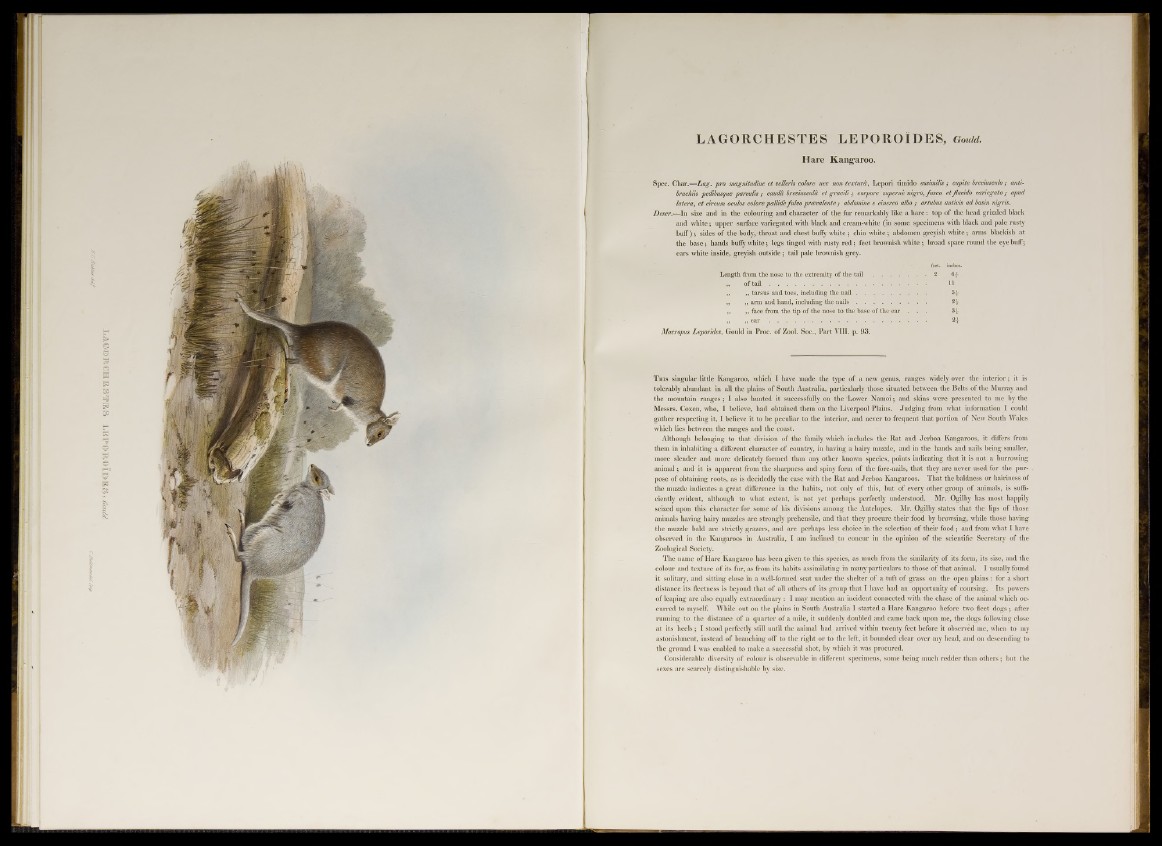
JL A ffiO R C H K S T E S JUSPOOEMJÏDBS.» £oM\
LAGORCHESTES LEPOROÏDES, Gould.
Hare Kangaroo.
Spec. Char.—L a g . pro magnitudine et velleris colore nee non t ex turà, Lepori timido assimilis ; capite breviusculo ; anti-
brachiis pedibusque parmlis ; caudà breviusculà et gracili ; corpore superne nigro, fosco et fiavido variegato ; apud
later a, et circum oculos colore pallide fulvo prcevalente ; abdomine e cinereo albo ; artubus anticis ad basin nigris.
Descr.— In size and in the colouring and character of the fur remarkably like a hare : top of the head grizzled black
and white ; upper surface variegated with black and cream-white (in some specimens with black and pale rusty
bufF); ; sides o f the body, throat and chest bufly white ; chin white ; abdomen greyish white ; arms blackish at
the base ; hands buffy white ; legs tinged with rusty red ; feet brownish white ; broad space round the eye buff;
ears white inside, greyish outside; tail pale brownish grey.
feet, inches.
Length from the nose to the extremity of the t a i l .....................................2 6£
r „ of tail ....................................................................................... H
,, ,, tarsus and toes, including the n a i l .................................................... 5-f
„ „ arm and hand, including the n a i l s .................................................... 2£
„ „ face from the . tip of the nose to the base of the ear . . . S \
„ „ e a r ......................................................................................................... 2£
Macropus Leporides, Gould in Proc. of Zool. Soc., Part VIII. p. 93.
T h i s singular little Kangaroo, which I have made the type o f a new genus, ranges widely over the interior ; it is
tolerably abundant in all the plains o f South Australia, particularly those situated between the Belts o f the Murray and
the mountain ranges ; I also hunted it successfully on the 'Lower Namoi ; and skins were presented to me by the
Messrs. Coxen, who, I believe, had obtained them on the Liverpool Plains. Judging from what information I could
gather respecting it, I believe it to be peculiar to the interior, and never to frequent that portion o f New South Wales
which lies between the ranges and the coast.
Although belonging to that division o f the family which includes the Rat and Jerboa Kangaroos, it differs from
them in inhabiting a different character of country, in having a hairy muzzle, and in the hands and nails being smaller,
more slender and more delicately formed than any other known species, points indicating that it is not a burrowing
animal ; and it is apparent from the sharpness and spiny form o f the fore-nails, that they are never used for the purpose
o f obtaining roots, as is decidedly the case with the Rat and Jerboa Kangaroos. That the baldness or hairiness of
the muzzle indicates a great difference in the habits, not only o f this, but o f every other group o f animals, is sufficiently
evident, although to what extent, is not yet perhaps perfectly understood. Mr. Ogilby has most happily
seized upon this character for some o f his divisions among the Antelopes. Mr. Ogilby states that the lips o f those
animals having hairy muzzles are strongly prehensile, and that they procure their food by browsing, while those having
the muzzle bald are strictly grazers, and are perhaps less choice in the selection o f their food ; and from what I have
observed in the Kangaroos in Australia, I am inclined to concur in the opinion o f the scientific Secretary of the
Zoological Society.
The name o f Hare Kangaroo has been given to this species, as much from the similarity o f its form, its size, and the
colour and texture o f its fur, as from its habits assimilating in many particulars to those of that animal. I usually found
it solitary, and sitting close in a well-formed seat under the shelter o f a tuft o f grass on the open plains : for a short
distance its fleetness is beyond that of all others of its group that I have had an opportunity o f coursing. Its powers
o f leaping are also equally extraordinary : I may mention an incident connected with the chase o f the animal which occurred
to myself. While out on the plains in South Australia I started a Hare Kangaroo before two fleet dogs ; after
running to the distance o f a quarter o f a mile, it suddenly doubled and came back upon me, the dogs following close
at its heels ; I stood perfectly still until the animal had arrived within twenty feet before it observed me, when to my
astonishment, instead o f branching off to the right or to the left, it bounded clear over my head, and on descending to
the ground I was enabled to make a successful shot, by which it was procured.
Considerable diversity of colour is observable in different specimens, some being much redder than others ; but the
sexes are scarcely distinguishable by size.